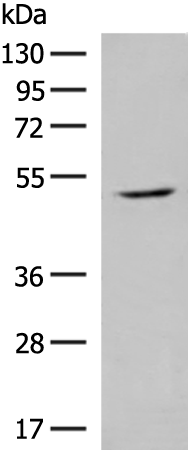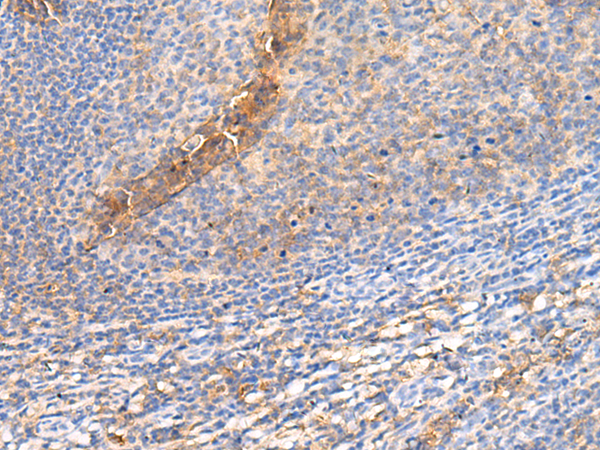

| WB | 咨询技术 | Human,Mouse,Rat |
| IF | 咨询技术 | Human,Mouse,Rat |
| IHC | 1/10-1/50 | Human,Mouse,Rat |
| ICC | 技术咨询 | Human,Mouse,Rat |
| FCM | 咨询技术 | Human,Mouse,Rat |
| Elisa | 1/5000-1/10000 | Human,Mouse,Rat |
| Aliases | PGR2; GPRg1b |
| WB Predicted band size | 51 kDa |
| Host/Isotype | Rabbit IgG |
| Antibody Type | Primary antibody |
| Storage | Store at 4°C short term. Aliquot and store at -20°C long term. Avoid freeze/thaw cycles. |
| Species Reactivity | Human |
| Immunogen | Synthetic peptide of human GPR142 |
| Formulation | Purified antibody in PBS with 0.05% sodium azide and 50% glycerol. |
+ +
以下是关于GPR142抗体的示例参考文献(部分内容为示例性概括,实际文献需通过学术数据库查询):
1. **"GPR142 Antibody Development for β-Cell Function Studies"**
- **作者**: Smith A et al.
- **摘要**: 研究开发了特异性靶向GPR142的多克隆抗体,用于检测其在胰岛β细胞中的表达,并验证其在调节胰岛素分泌中的功能,为糖尿病机制研究提供工具。
2. **"Therapeutic Potential of Anti-GPR142 Antibodies in Metabolic Disorders"**
- **作者**: Zhang L et al.
- **摘要**: 通过体外和动物模型证明,阻断GPR142的单克隆抗体可改善高血糖症状,抑制受体活性可能成为2型糖尿病的新型治疗策略。
3. **"Structural Characterization of GPR142 Using Conformation-Specific Antibodies"**
- **作者**: Kobilka B et al.
- **摘要**: 利用构象特异性抗体结合冷冻电镜技术解析GPR142的激活态结构,揭示其配体结合域特征,为药物设计提供结构基础。
4. **"GPR142 Antibody-Based Biomarker Screening in Obesity Models"**
- **作者**: Tanaka M et al.
- **摘要**: 采用抗GPR142抗体分析肥胖小鼠模型中受体表达水平的变化,发现其与脂肪组织炎症的相关性,提示其在代谢综合征中的潜在作用。
**注意**:以上为示例性内容,真实文献需通过PubMed、Google Scholar或Web of Science等平台检索关键词(如"GPR142 antibody" "GPR142 antagonist")获取。
**Background of GPR142 Antibodies**
GPR142 is a G protein-coupled receptor (GPCR) belonging to the rhodopsin-like receptor family. Initially identified as an orphan receptor, it has gained attention due to its potential role in metabolic regulation, particularly in insulin secretion and feeding behavior. GPR142 is primarily expressed in pancreatic islets, gastrointestinal tissues, and specific brain regions. Its activation by tryptophan-derived metabolites, such as tryptamine and 5-hydroxyindole, suggests involvement in nutrient sensing and metabolic homeostasis.
GPR142 antibodies are essential tools for studying the receptor's expression, localization, and function. They are commonly used in techniques like immunohistochemistry, Western blotting, and flow cytometry to detect GPR142 in tissue samples or cell lines. Polyclonal and monoclonal antibodies targeting different epitopes (e.g., extracellular or intracellular domains) enable researchers to investigate receptor trafficking, signaling pathways, and interactions with ligands or downstream effectors.
Recent studies highlight GPR142 as a potential therapeutic target for metabolic disorders, including type 2 diabetes and obesity. Antibodies against GPR142 also aid in validating preclinical models, such as knockout mice, to elucidate its physiological roles. However, challenges remain in ensuring antibody specificity, as cross-reactivity with related GPCRs can occur. Validated GPR142 antibodies are critical for advancing research into its mechanisms and exploring its therapeutic potential in metabolic and neurological diseases.
×